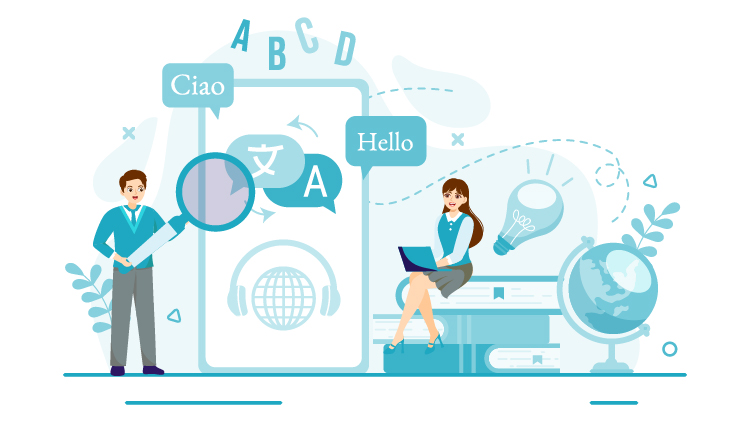
Artificial Intelligence and Machine Learning in Translation
One of the translation industry trends is experiencing a significant shift with the advent of Artificial Intelligence (AI) and Machine Learning (ML) technologies. These cutting-edge tools are revolutionizing translations, making the process faster and more accurate.
AI and ML algorithms can now analyze vast amounts of data, allowing them to learn and understand language patterns, nuances, and context. This enables them to produce highly accurate translations that rival the work of a human translator. With the demand for translation services proliferating, AI and ML are becoming invaluable tools for translation agencies and professionals.
One translation trend that has emerged with AI and ML is Translation Memory (TM). TM database stores previously translated segments, allowing translators to leverage pre-translated content to speed up translation. This not only saves time but also ensures consistency across different translation projects.
Another translation trend fueled by AI and ML is Statistical Machine Translation (SMT). SMT utilizes statistical models to generate translations based on patterns and probabilities derived from large datasets. This technology has dramatically improved the accuracy of machine translation and has become an essential tool for many professional translators.
However, it is essential to note that while AI and ML are powerful tools, they are not meant to replace human translators. The human touch is crucial for accurate translation, especially regarding complex or culturally sensitive content. Human intervention is necessary to ensure that translations are linguistically accurate and culturally appropriate for the target audience.
Localization for Voice Search
As technology continues to advance, voice search is becoming increasingly popular. More and more people use voice assistants like Siri, Alexa, and Google Assistant to find information, make purchases, and interact with their devices. This shift towards voice-based interactions has created a new challenge for the language translation industry – localization for voice search.
Localization for voice search involves adapting and optimizing content for different languages and dialects to ensure accurate and natural-sounding voice responses. This process requires a deep understanding of the target language, local dialects, and cultural nuances. Translation technology is crucial in this process, enabling efficient and accurate translation of voice queries and responses.
To excel in localization for voice search, translation professionals must also prioritize high-quality translation and terminology management. Voice search queries often involve complex and nuanced language, and it is essential to ensure that translations are accurate and contextually appropriate. Additionally, having a solid online presence is vital, as voice search is primarily conducted through digital devices.
The Machine Translation Market is also playing a significant role in localization for voice search. With the advancements in neural machine translation, the accuracy and quality of automated translations have greatly improved. This technology can aid in translating voice queries and responses quickly and efficiently.
As the language translation industry adapts to the rise of voice search, professionals must stay updated on the latest translation technology and trends. Embracing localization for voice search will enable businesses to reach a wider audience and provide a seamless and personalized user experience. So, keep an eye on this emerging trend and ensure that your translation services are equipped to meet the language translation industry's demands in the voice search era.
Video Translation and Subtitling
With the increasing popularity of video content on platforms like YouTube, Netflix, and social media, video translation and subtitling have become essential in reaching a global audience. Video translation services offer the opportunity to expand the reach of your videos by making them accessible to non-native speakers. Whether it's a marketing video, a tutorial, or an entertainment piece, translating the audio and adding subtitles in different languages can significantly enhance the viewer experience and increase engagement.
Video translation and subtitling also play a significant role in ensuring accurate communication and understanding in multilingual environments. They allow individuals from different linguistic backgrounds to access and comprehend the content, breaking down language barriers and fostering inclusivity.
Additionally, video translation and subtitling provide a valuable SEO advantage. By translating video titles, descriptions, and keywords, you can optimize your videos for search engines in different languages, improving their discoverability and ranking.
To provide high-quality video translation and subtitling, working with experienced professionals fluent in both the source and target languages is essential. They can accurately capture the meaning and tone of the original video while adapting it for the target audience.
Neural Machine Translation and Post Editing
Neural Machine Translation (NMT) has emerged as a game-changer in the translation industry. With artificial intelligence and deep learning algorithms, NMT systems can produce more accurate and natural-sounding translations than ever before. NMT models are trained on vast amounts of multilingual data, allowing them to understand the nuances of different languages and generate high-quality translations.
While NMT has dramatically improved the efficiency and accuracy of machine translation, it is essential to note that post-editing is still a crucial step in the process. Post-editing involves the review and refinement of machine-generated translations by human translators. This ensures the final translation is accurate and maintains the original text's intended meaning and tone.
Post-editing allows human translators to catch errors or inconsistencies in the machine-generated translation and make necessary revisions. It also incorporates context-specific knowledge and cultural nuances that may not be captured by the NMT system alone.
By combining the power of NMT with post-editing, translation agencies and professionals can deliver high-quality translations efficiently. The collaboration between humans and machines in the translation process maximizes the strengths of both, resulting in translations that are accurate, natural, and culturally appropriate.
In the coming years, the use of NMT and post-editing will continue growing as the demand for fast and reliable translations increases. As technology advances, NMT systems will become more sophisticated, enhancing machine translation capabilities. However, the human touch will always be indispensable in ensuring the highest quality translations that meet the specific needs of clients and target audiences.
Emphasis on Quality Control and Human Review
As technology advances in the translation industry, there is an increasing emphasis on quality control and human review. While Artificial Intelligence (AI) and Machine Learning (ML) tools have revolutionized the translation process, they are imperfect and can still produce inaccuracies or cultural misunderstandings. That's where quality control and human review come in.
Translation agencies and professionals recognize the importance of having a solid quality control process to ensure the accuracy and appropriateness of translations. This includes implementing rigorous proofreading and editing procedures and utilizing specialized software for quality assurance. By thoroughly reviewing translations, human experts can catch any errors, inconsistencies, or mistranslations that may have been missed by AI or ML algorithms.
Additionally, human review is crucial for cultural adaptation and sensitivity. Language is deeply connected to culture, and a literal translation may not always convey the intended meaning or resonate with the target audience. Human translators have the cultural knowledge and expertise to adapt translations in a culturally appropriate way and ensure effective communication.
While AI and ML technologies have undoubtedly improved the efficiency and speed of translation, they cannot replace human translators' critical thinking and cultural awareness. By placing a strong emphasis on quality control and human review, translation professionals can deliver translations that are not only accurate and precise but also culturally sensitive and impactful.
Remote Interpreting Services
Remote interpreting services have become increasingly essential in today's globalized world. With technological advancements and the rise of virtual communication, the demand for remote interpreting has grown significantly. Remote interpreting allows individuals to communicate across different languages and cultures without needing in-person interpreters.
The benefits of remote interpreting services are numerous. They provide quick and efficient access to interpretation services, saving time and resources. Remote interpreting also offers flexibility, as interpreters can be accessed from anywhere worldwide, eliminating geographical limitations. This is particularly advantageous in emergencies or when specialized language expertise is required.
One popular form of remote interpreting is video remote interpreting (VRI), which allows individuals to access interpreting services through video conferencing platforms. This method offers visual cues and facial expressions, enhancing communication and understanding. Telephone interpreting is another commonly used remote interpreting service, providing immediate access to interpreters via phone calls.
While remote interpreting services have many advantages, it is essential to consider certain factors to ensure optimal quality. A stable internet connection, high-quality audio and video equipment, and skilled interpreters are necessary for successful remote interpreting sessions. Additionally, the privacy and security of sensitive information must be maintained during remote interpreting sessions.
In summary, remote interpreting services are crucial in breaking down language barriers and facilitating effective communication in multilingual environments. By embracing these services, businesses and individuals can overcome linguistic obstacles and engage with a global audience seamlessly and efficiently.
Importance of Cultural Awareness and Adaptation
In today's globalized world, cultural awareness and adaptation are more critical than ever in the translation industry. Language is deeply intertwined with culture; a literal translation may not always capture the intended meaning or resonate with the target audience. That's where cultural awareness and adaptation come in.
Translators with a strong understanding of the target culture can ensure that translations are linguistically accurate and culturally appropriate. They have the knowledge and expertise to adapt content in a way that considers cultural nuances, sensitivities, and preferences.
Cultural awareness and adaptation are crucial in effective communication and building meaningful connections with the target audience. By understanding the cultural context, translators can tailor their translations to be more relatable and engaging. This not only improves comprehension but also helps to foster a sense of trust and authenticity.
Furthermore, cultural adaptation is essential for businesses looking to expand into new markets. Adapting marketing materials, websites, and products to the cultural preferences of the target audience can significantly impact the success of international ventures. It respects the local culture and builds stronger connections with potential customers.
In summary, cultural awareness and adaptation are integral to providing high-quality translations beyond mere language accuracy. They enable effective communication, promote inclusivity, and open doors to new opportunities in the global market. By embracing cultural diversity and incorporating it into translation practices, businesses can create impactful content that resonates with their target audience and sets them apart from the competition.
Impact of Social Media on the Translation Industry
Social media has significantly impacted the translation industry, revolutionizing how information is disseminated and consumed globally. With the rise of platforms like Facebook, Twitter, and Instagram, communication has become faster, more interactive, and more inclusive. This has created new opportunities and challenges for translators and language professionals.
Social media platforms have made it easier for businesses and individuals to connect with people worldwide, breaking down language barriers and fostering global communication. Translators play a vital role in ensuring that content shared on social media is accessible to non-native speakers, enabling businesses to reach a wider audience and expand their online presence.
One of the key challenges in translating social media content is the character limit imposed by platforms like Twitter. Translators must find creative ways to condense and convey the original message while preserving its meaning and tone. They must also adapt the translation to fit the target audience's cultural context and linguistic nuances, ensuring the content resonates with them.
Social media platforms constantly evolve, with new features, hashtags, and slang emerging regularly. Translators must stay current with these trends to provide accurate and relevant translations. This requires continuous learning and monitoring of social media conversations to capture the latest linguistic and cultural developments.
Social media has transformed the translation industry, presenting opportunities and challenges. By embracing these changes and staying abreast of social media trends, translators can leverage the power of these platforms to connect people across languages and cultures. The impact of social media on the translation industry will continue to shape how information is shared and understood, making it an exciting and dynamic field to be a part of.
Frequently Asked Questions
In 2023, the translation industry is witnessing several trends, including increased demand for machine translation, a focus on localization for global markets, the rise of AI-powered tools, and the importance of data security in translation services.
Machine translation, fueled by advancements in AI and neural networks, is becoming more accurate and accessible. It's used for quick translations, but human translators are still essential for nuanced and context-sensitive content.
Localization is crucial as businesses aim to expand globally. It involves adapting content to specific markets' cultural and linguistic preferences, ensuring a more personalized and engaging user experience.
AI tools are augmenting human translation but not replacing them entirely. Human translators provide context, cultural understanding, and accuracy that AI alone cannot match, especially for complex and creative content.
https://www.universal-translation-services.com/ahead-of-the-game-latest-translation-industry-trends-for-2023/


Comments
Post a Comment